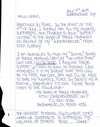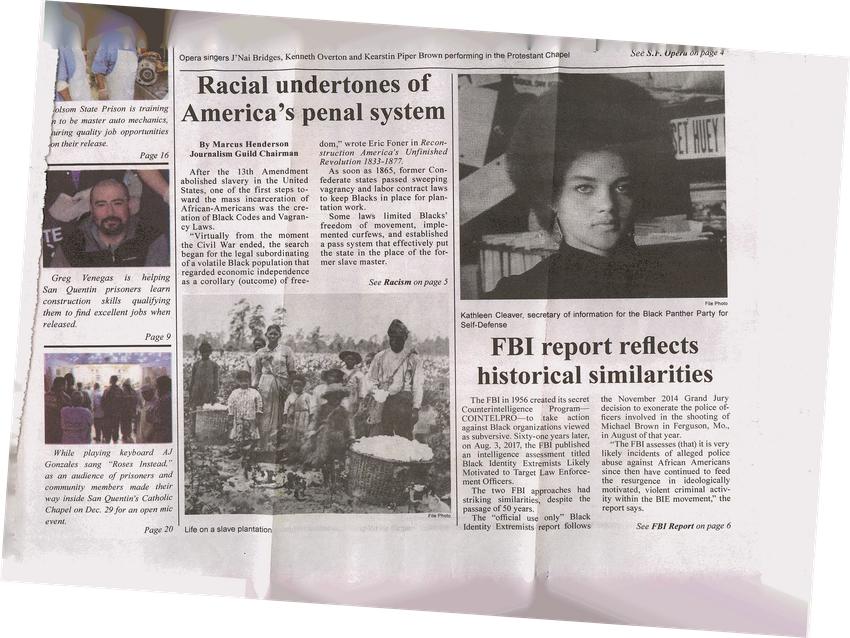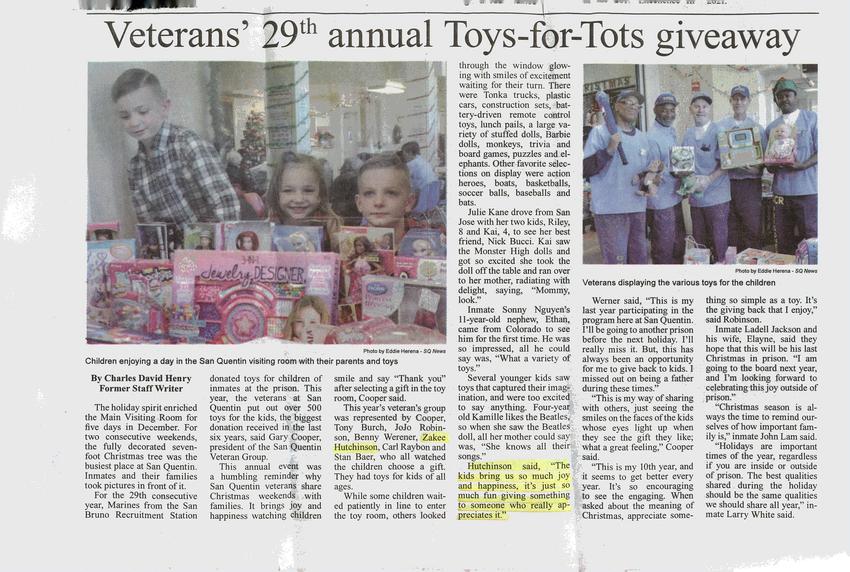
Transcription
[Two pages of newspaper clippings.]
https://sanquentinnews.com/racial-undertones-americas-penal-system/
Racial undertones of America’s penal system
February 13, 2018 By Marcus Henderson
After the 13th Amendment abolished slavery in the United States, one of the first steps toward the mass incarceration of African-Americans was the creation of Black Codes and Vagrancy Laws.
“Virtually from the moment the Civil War ended, the search began for the legal subordinating of a volatile Black population that regarded economic independence as a corollary (outcome) of freedom,” wrote Eric Foner in Reconstruction America’s Unfinished Revolution 1833-1877.
With 343 homicides in 2017, Baltimore “had the highest murder rate in its history, and by far the highest among the nation’s 30 largest cities,” according to The New York Times 1-17-18
As soon as 1865, former Confederate states passed sweeping vagrancy and labor contract laws to keep Blacks in place for plantation work.
Some laws limited Blacks’ freedom of movement, implemented curfews, and established a pass system that effectively put the state in the place of the former slave master.
“The entire complex of labor regulations and criminal laws was enforced by a police apparatus and judicial system in which Blacks enjoyed virtually no voice whatever,” Foner wrote.
Most urban police forces and militias were staffed with Confederate veterans who still wore gray uniforms. Blacks called these militias the “patrol.” The patrols frequently ransacked Blacks’ homes to seize shotguns and personal property. In addition, Blacks who refused to sign plantation contracts suffered abuse.
Vagrancy laws punished Blacks for disorderly conduct, idleness, and those who “misspend what they earn.” Criminal offenses included preaching the gospel without a license, insulting language or gestures and malicious mischief.
Since employers could no longer use corporal punishment against Black workers, courts could mandate whippings for vagrancy or petty theft. The courts could impose long prisons terms and force prisoners to hard labor on public works without compensation.
By 1867, Blacks constituted about one-third of Texas convicts. The state leased out 90 percent for railroad labor, noted Foner.
“Convicts had no meaningful legal rights at this time and no effective redress,” wrote Michelle Alexander, in The New Jim Crow. “The state of Mississippi eventually moved from hiring convict labor to organizing its own labor camp, known as Parchman Farm. It was not alone.
“During the decade following Redemption [the Southerners’ term for Reconstruction], the convict population grew 10 times faster than the general population: ‘Prisoners became younger and Blacker, and the length of their sentences soared.’ It was the nation’s first prison boom,” continued Alexander.
Blacks had little confidence in the Southern court system when arrested by White sheriffs, tried by White judges, and convicted by all-White juries. Blacks started to petition the Freedman’s Bureau or the army to handle disputes and punish crimes.
Prison chain gang of slaves
Prison chain gang of slaves
If Whites committed crimes against Blacks, the courts either acquitted them or they received lenient sentences. Between 1865 and 1866, Texas courts indicted some 500 White men for the murder of Blacks with no convictions, highlighted Foner.
Black women and children were not exempt from the targets of the states.
Louisiana and Texas mandated labor contract laws that included all members of the family who were able to work, thus stopping women from leaving the fields. In addition, apprenticeship laws allowed judges to bind Black orphans and juveniles to White employers.
“Although all these measures inspired protest from Blacks, the most bitter complaints centered on apprenticeship laws…an excuse for providing planters with the unpaid labor of Black minors,” wrote Foner.
Courts in Maryland and North Carolina sent thousands of children to White “guardians” without consent or sometimes without the knowledge of their parents. Parents petitioned the Freedmen’s Bureau for the release of their children from court-ordered apprenticeships.
Indentured servants, children and slaves in the field
Indentured servants, children and slaves in the field
Bureau agents and local justices of the peace were still releasing Black children from the “apprenticeships” as late as 1867, noted Foner.
Even under those trials and hardships, African-Americans built social and religious institutions that survived the end of Reconstruction, noted both Alexander and Foner. Schools began to open. The literacy rate rose, successful businesses started, and educated Blacks populated local legislatures.
But as the 21st century arrived, the legal framework of racial profiling, biased sentencing policies, political and employment discrimination has virtually and literally trapped Blacks at the bottom of a hierarchy with racial overtones by labeling them felons, noted Alexander.
“The slave went free; stood a brief moment in the sun; then moved back again to slavery,” said W.E.B. Du Bois.
PPI’s “Correctional Control: Incarceration and Supervision by State” issued on June 1, is the first report to aggregate data on all types of correctional control nationwide.
====
https://sanquentinnews.com/veterans-29th-annual-toys-tots-giveaway/
Veterans’ 29th annual Toys-for-Tots giveaway
February 21, 2018 By Charles David Henry
The holiday spirit enriched the Main Visiting Room for five days in December. For two consecutive weekends, the fully decorated seven-foot Christmas tree was the busiest place at San Quentin. Inmates and their families took pictures in front of it.
For the 29th consecutive year, Marines from the San Bruno Recruitment Station donated toys for children of inmates at the prison. This year, the veterans at San Quentin put out over 500 toys for the kids, the biggest donation received in the last six years, said Gary Cooper, president of the San Quentin Veteran Group.
This annual event was a humbling reminder why San Quentin veterans share Christmas weekends with families. It brings joy and happiness watching children smile and say “Thank you” after selecting a gift in the toy room, Cooper said.
Children enjoying a day in the San Quentin visiting room with their parents and toys
Children enjoying a day in the San Quentin visiting room with their parents and toys
This year’s veteran’s group was represented by Cooper, Tony Burch, JoJo Robinson, Benny Werener, Zakee Hutchinson, Carl Raybon and Stan Baer, who all watched the children choose a gift. They had toys for kids of all ages.
While some children waited patiently in line to enter the toy room, others looked through the window glowing with smiles of excitement waiting for their turn. There were Tonka trucks, plastic cars, construction sets, battery-driven remote control toys, lunch pails, a large variety of stuffed dolls, Barbie dolls, monkeys, trivia and board games, puzzles and elephants. Other favorite selections on display were action heroes, boats, basketballs, soccer balls, baseballs and bats.
Julie Kane drove from San Jose with her two kids, Riley, 8 and Kai, 4, to see her best friend, Nick Bucci. Kai saw the Monster High dolls and got so excited she took the doll off the table and ran over to her mother, radiating with delight, saying, “Mommy, look.”
Inmate Sonny Nguyen’s 11-year-old nephew, Ethan, came from Colorado to see him for the first time. He was so impressed, all he could say was, “What a variety of toys.”
Several younger kids saw toys that captured their imagination, and were too excited to say anything. Four-year old Kamille likes the Beatles, so when she saw the Beatles doll, all her mother could say was, “She knows all their songs.”
Hutchinson said, “The kids bring us so much joy and happiness, it’s just so much fun giving something to someone who really appreciates it.”
Werner said, “This is my last year participating in the program here at San Quentin. I’ll be going to another prison before the next holiday. I’ll really miss it. But, this has always been an opportunity for me to give back to kids. I missed out on being a father during these times.”
“This is my way of sharing with others, just seeing the smiles on the faces of the kids whose eyes light up when they see the gift they like; what a great feeling,” Cooper said.
“This is my 10th year, and it seems to get better every year. It’s so encouraging to see the engaging. When asked about the meaning of Christmas, appreciate something so simple as a toy. It’s the giving back that I enjoy,” said Robinson.
Inmate Ladell Jackson and his wife, Elayne, said they hope that this will be his last Christmas in prison. “I am going to the board next year, and I’m looking forward to celebrating this joy outside of prison.”
“Christmas season is always the time to remind ourselves of how important family is,” inmate John Lam said.
“Holidays are important times of the year, regardless if you are inside or outside of prison. The best qualities shared during the holiday should be the same qualities we should share all year,” inmate Larry White said.
If an incarcerated veteran wants to learn more about VHV or if they or their family may qualify for additional benefits, please contact:
Mary Donovan, Executive Director of VHV
PO BOX 432
San Quentin, CA 94964
mary@veteranshealingveterans.org
The VHV website is veteranshealingveterans.org
====
[Two pages of motivational images with quotes.]
"Live with intention.
Walk to the edge.
Listen hard.
Practice wellness.
Play with abandon.
Laugh.
Choose with no regret.
Appreciate your friends.
Continue to learn.
Live as if this is all there is."
—Mary Anne Radmacher
Be somebody
nobody thought
you could be.
—hpylyrikz.com
"The pessimist sees difficulty in
every opportunity.
The optimist sees the
opportunity in every difficulty."
—Winston Churchill
Other posts by this author
|
2019 dec 25

|
2019 aug 28

|
2019 aug 26

|
2019 aug 9

|
2019 jul 13

|
2019 jul 13

|
More... |





Replies